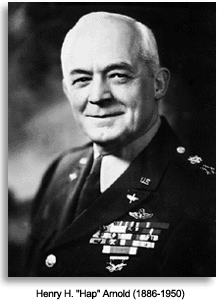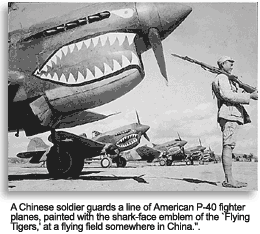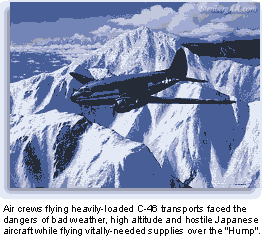A veteran pilot once explained the "CBI* takeoff" to newcomers: "If you can see the end of the runway through the rain and mist, then a takeoff is expected."
Following the invasion of China in 1937, Japanese forces succeeded in controlling virtually all of China's Pacific coast, and large parts of the interior — giving the Japanese Navy command of all ocean approaches. In the spring of 1942, Japanese units overran Burma (on India's northern border), cutting off the last significant land routes that supplied the struggling armies of Generalissimo Chiang Kai-shek in China.
The United States and its allies needed to keep China in the war because its forces preoccupied hundreds of thousands of Japanese troops. Holding that valuable Chinese turf permitted the Allies to attack Axis powers in the European theater, at the same time building a necessary launch site for an Allied attack on Japan's home islands. However, that grand strategy could only work if China and allied troops could be routinely supplied.
In April 1942, pilots started flying the "Hump," and continued missions until 1945, when the Burma Road was reopened. The dangerous 530-mile long passage over the Himalayan Mountains took its toll. Nearly 1,000 men and 600 Air Transport Command (ATC) planes were lost over the hump by the end of China-Burma-India Theater (CBI) operations. In addition, China National Aviation Corporation (CNAC) lost 38 planes and 88 airmen.
First to fly the hump
During the 1930s, the CNAC had pioneered air routes over the Himalayas. CNAC operated with the support of the Chinese government and the expertise of Pan American Airways. CNAC became a contractor to operate air cargo services between India and China, although it was clear that far more capacity was needed. Accordingly, the 10th Air Force, based in India, took responsibility for substantial air cargo flights and began operations over the hump in April 1942.
 In October 1942, General of the Air Force Henry H. "Hap" Arnold decided to put the ATC in command of all hump operations, and 10th Air Force units on hump assignments were transferred to the ATC in December. The ATC, with authority to handle all airlift requirements in the theater of operations, brought its special experience to sort out the problems in air transportation and cargo flying.
The Flying Tigers
The U.S. began to help the Chinese defend itself even before the Pearl Harbor Attack. Lend-Lease aid began in April 1941, and in June the Flying Tigers were sent to fly missions against the Japanese.
When Japan cut off the Burma Road, CNAC (with planes commandeered from U.S. domestic airlines) began the treacherous route over the Himalayas and became the lone supplier of China’s combat forces along with United States Army Air Force (USAAF) General Claire Chennault’s American Volunteer Group – the Flying Tigers.
On May 5th, 1942, Japan’s elite Red Dragon Armored Division approached the last barrier to China’s back door — the mile-deep Salween River gorge. If the Japanese crossed the bridge over that river, China would be out of the war.
In October 1942, General of the Air Force Henry H. "Hap" Arnold decided to put the ATC in command of all hump operations, and 10th Air Force units on hump assignments were transferred to the ATC in December. The ATC, with authority to handle all airlift requirements in the theater of operations, brought its special experience to sort out the problems in air transportation and cargo flying.
The Flying Tigers
The U.S. began to help the Chinese defend itself even before the Pearl Harbor Attack. Lend-Lease aid began in April 1941, and in June the Flying Tigers were sent to fly missions against the Japanese.
When Japan cut off the Burma Road, CNAC (with planes commandeered from U.S. domestic airlines) began the treacherous route over the Himalayas and became the lone supplier of China’s combat forces along with United States Army Air Force (USAAF) General Claire Chennault’s American Volunteer Group – the Flying Tigers.
On May 5th, 1942, Japan’s elite Red Dragon Armored Division approached the last barrier to China’s back door — the mile-deep Salween River gorge. If the Japanese crossed the bridge over that river, China would be out of the war.
 Flying Tiger P-40s and Chinese ground forces destroyed the bridge. The Japanese hauled pontoons to the river’s edge while waiting trucks and tanks snaked for miles along the Salween’s bank. Chennault’s Tigers fought them off. The remnants of Japan’s elite army turned back. Never before had an invading army been defeated solely by air power. It was a defining moment for the Flying Tigers, CNAC and for aviation history.
Combat Cargo Groups
British CBI Theater commander Lord Louis Mountbatten, remembering a past promise of air support from President Roosevelt, now got his wish.
Combat Cargo Groups were soon on the way. The newly introduced units' sole purpose in the theater was to be air-resupply, supplying ground units in a combat zone. The First through Fourth Combat Cargo Groups were deployed to Karachi, India, via the South Atlantic route on May 19, 1944. Each of the combat cargo groups was to consist of four squadrons, each with 25 aircraft.
One hundred new C-47-A aircraft were sent to India, along with 100 experienced multi-engine-rated pilots, 100 experienced multi-engine-rated copilots, and 75 additional reserve flying officers. Each aircraft was assigned a crew chief and radio operator, plus a navigator on loan from the ATC.
Flying Tiger P-40s and Chinese ground forces destroyed the bridge. The Japanese hauled pontoons to the river’s edge while waiting trucks and tanks snaked for miles along the Salween’s bank. Chennault’s Tigers fought them off. The remnants of Japan’s elite army turned back. Never before had an invading army been defeated solely by air power. It was a defining moment for the Flying Tigers, CNAC and for aviation history.
Combat Cargo Groups
British CBI Theater commander Lord Louis Mountbatten, remembering a past promise of air support from President Roosevelt, now got his wish.
Combat Cargo Groups were soon on the way. The newly introduced units' sole purpose in the theater was to be air-resupply, supplying ground units in a combat zone. The First through Fourth Combat Cargo Groups were deployed to Karachi, India, via the South Atlantic route on May 19, 1944. Each of the combat cargo groups was to consist of four squadrons, each with 25 aircraft.
One hundred new C-47-A aircraft were sent to India, along with 100 experienced multi-engine-rated pilots, 100 experienced multi-engine-rated copilots, and 75 additional reserve flying officers. Each aircraft was assigned a crew chief and radio operator, plus a navigator on loan from the ATC.
 The four combat cargo groups used in the CBI theater were not the only cargo-carrying air transport units. There were in addition, the ATC Army Air Force Base Units, the Ferry Command Squadrons, the Troop Carrier Groups, the Air Commando Groups, the CNAC, Royal Air Force Groups, and Royal Australian Air Force Groups and Squadrons. Tackling the hump on numerous occasions, they all served with distinction in the CBI theater.
Problems along the way
During the first two months of piloting the hump, the 10th Air Force carried 196 tons of cargo, and the CNAC delivered 112 tons. Summer monsoons played havoc with aircraft, nearly terminating all flights. The two units were delivering 1,000 tons a month by the end of the year. However, those were not nearly enough supplies required to adequately sustain the Chinese each month. A new game plan had to be organized.
Improvements
Operational efficiency began to improve with the delivery of more airplanes and personnel, better weather forecasting, accumulated flight experience, and newly built airfields constructed with proper drainage.
The big push came in the form of high-level Allied conferences during the spring of 1943. Those meetings established a timetable for major European offensives and also resulted in agreements to accelerate the offensive against Japanese forces in Asia. President Roosevelt called for a goal of 10,000 tons a month for the airlift into China.
Military planners quickly shifted workers and equipment from road to airfield construction. By the spring of 1945, a determined effort resulted in 13 primary bases for the ATC in India and six in China.
ATC transports carried some equipment across the hump to Chinese construction sites; however, the major labor force on both sides of the Himalayas involved tens of thousands of local workers. Consisting of men, women, and children, villagers delivered stone chips and equipment in baskets of woven vines.
The four combat cargo groups used in the CBI theater were not the only cargo-carrying air transport units. There were in addition, the ATC Army Air Force Base Units, the Ferry Command Squadrons, the Troop Carrier Groups, the Air Commando Groups, the CNAC, Royal Air Force Groups, and Royal Australian Air Force Groups and Squadrons. Tackling the hump on numerous occasions, they all served with distinction in the CBI theater.
Problems along the way
During the first two months of piloting the hump, the 10th Air Force carried 196 tons of cargo, and the CNAC delivered 112 tons. Summer monsoons played havoc with aircraft, nearly terminating all flights. The two units were delivering 1,000 tons a month by the end of the year. However, those were not nearly enough supplies required to adequately sustain the Chinese each month. A new game plan had to be organized.
Improvements
Operational efficiency began to improve with the delivery of more airplanes and personnel, better weather forecasting, accumulated flight experience, and newly built airfields constructed with proper drainage.
The big push came in the form of high-level Allied conferences during the spring of 1943. Those meetings established a timetable for major European offensives and also resulted in agreements to accelerate the offensive against Japanese forces in Asia. President Roosevelt called for a goal of 10,000 tons a month for the airlift into China.
Military planners quickly shifted workers and equipment from road to airfield construction. By the spring of 1945, a determined effort resulted in 13 primary bases for the ATC in India and six in China.
ATC transports carried some equipment across the hump to Chinese construction sites; however, the major labor force on both sides of the Himalayas involved tens of thousands of local workers. Consisting of men, women, and children, villagers delivered stone chips and equipment in baskets of woven vines.
 Success over the hump
By the end of World War II, newly appointed hump commander Brig. General William H. Turner, had increased the ATC Division from 369 to 722 aircraft, and personnel numbers improved from 26,000 to more than 84,000. Final offensives against the Japanese resulted in one ATC transport taking off every three minutes. Early in 1945, the monthly cargo delivered to China reached 44 thousand tons - peaking at 71 thousand in July. The war would be over the following month.
Success over the hump
By the end of World War II, newly appointed hump commander Brig. General William H. Turner, had increased the ATC Division from 369 to 722 aircraft, and personnel numbers improved from 26,000 to more than 84,000. Final offensives against the Japanese resulted in one ATC transport taking off every three minutes. Early in 1945, the monthly cargo delivered to China reached 44 thousand tons - peaking at 71 thousand in July. The war would be over the following month.